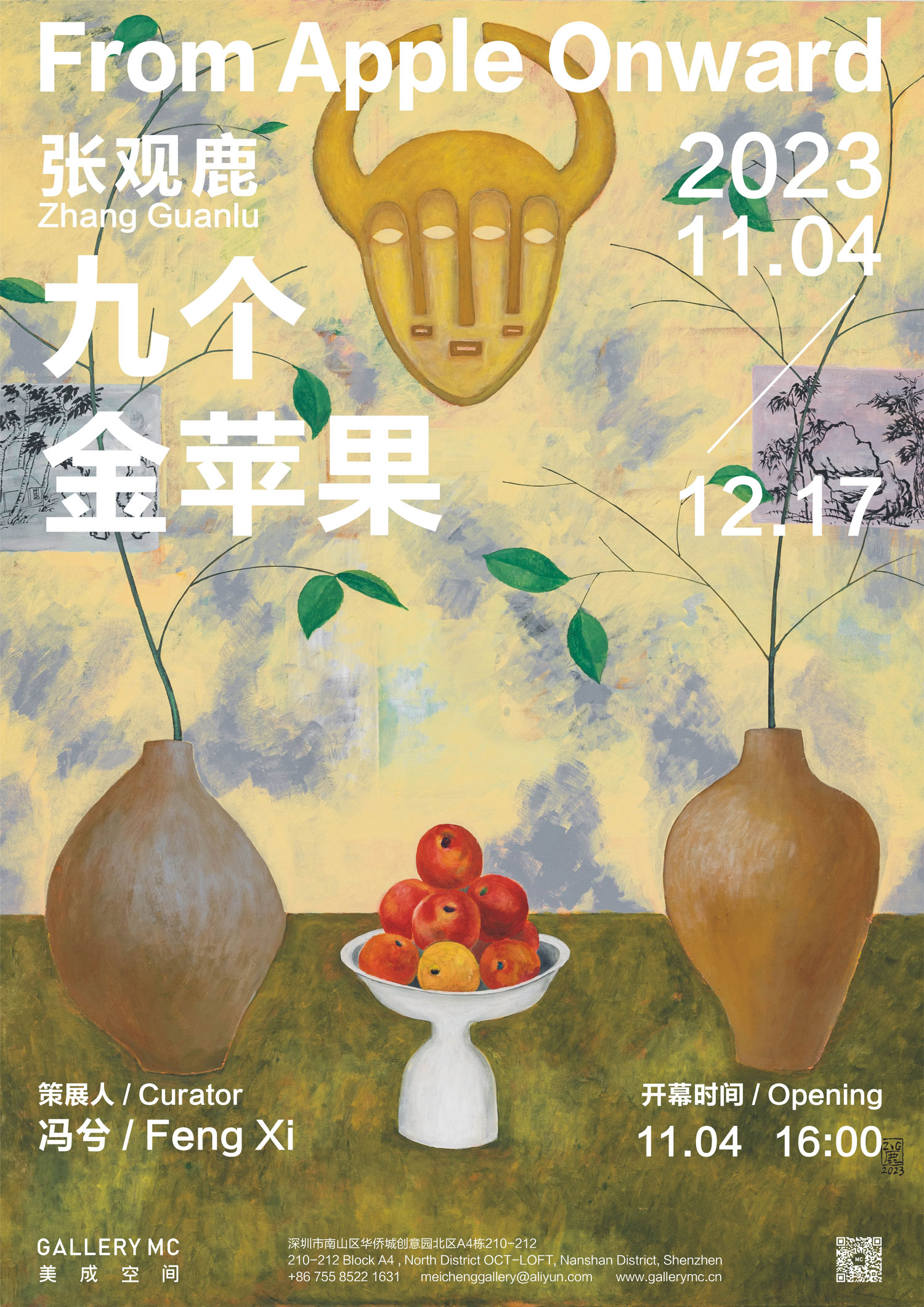展期 Period:
2023.11.4—2023.12.17
艺术家 Artist:
策展人 Curator:
地点 Venue:
新闻稿 Press Release:
美成空间荣幸地宣布将于2023年11月4日推出艺术家张观鹿首次机构个展“九个金苹果”,展览由策展人冯兮策划,呈现艺术家张观鹿于2017-2023年间创作的14件“苹果系列”的绘画作品,将持续展出至12月17日。
“还会有别的提菲斯,驾阿戈征舰
载满舟英雄,另一些新的战争飙起
还会有孔武的阿喀琉斯般的英雄
再征特洛伊般的城邑”
诗人维吉尔著名的诗歌《牧歌》第四篇中诗意的讲述,“孔武的阿喀琉斯”充满了古罗马时代对英雄无限的赞美与憧憬。“再征特洛伊般的城邑”的意向,如飘荡在神话和人间的一颗引发嫉妒、贪婪以及战争的金苹果,再次从掌管纠纷的女神厄里斯手中降临在每个人的面前,嘴角不经意地流露出狡黠而迷人的笑容。当苹果变成权力的归属,美女成为占有的目标,欲望和意志的较量决定着不同命运的方向。
张观鹿的“苹果系列”将苹果抽离出物质的现实意义,描述成塞尚绘画价值的凝结体,以及现代艺术开端与发展的标志。亦是现代主义自20世纪引入中国后,影响了几代艺术家,并成为衔接现当代艺术启蒙的明确的指涉。中国古代绘画极少以静物作为创作的主题和内容,张观鹿借助“苹果”这一现代主义绘画的意向,展开关于东西方绘画区别性和共同性进行的多元化的研究与交流方式。“九”在中国语境当中是最为贵重的数字意向,属于阳数中的极数。“十”为“尊”,有着人情或事态圆满之意,正是满则溢,拥有缺陷是美好的,故择“九”而弃“十”,定名为“九个金苹果”。
“九个金苹果”依据张观鹿的“苹果系列”中不同的叙述对象,将作品进行分类呈现,使用九种从现代主义语言中编辑而来的绘画逻辑与打开方式,整理出从“现代主义”的视角进入当代艺术语言的九个端口:1.编辑、2.静物、3.女人体、4.中国画、5.现代、6.圣物、7.超现实、8.平等、9.革命性。展览根据个人知识系统铺陈的章回性的输出,将作品分为综上所述的思考样本,呈现对应“九个金苹果”的关联性。
“他日当你在催人成熟的岁月里变成男子汉
水手们将不须再扬远帆,松木的三桅船
也不用往返海途易货经营”
《牧歌》的第四篇中另外四句的诗意,似乎引出了随着时间的成长,人会经历不同身份的转变和职业的选择。2013年,作为《艺术时代》主编的“康学儒”为了丰富发刊词的新颖和多样性,开始亲手在纸上创作“编辑”系列的作品,并将其作为发刊词的“文字”进行刊登,也由此开始了绘画的创作,距本次展览正巧经历了十年的时间。“九个金苹果”作为张观鹿第一个正式的艺术机构个展,亦是“张观鹿”艺术家身份公开确立的“典礼”。自此,艺术界缺少了一位优秀的策展人康学儒,却“诞生”了一位对绘画的学理、认知与见地,区别于学院教育系统毕业或专业绘画出身的艺术家,他在十年的绘画过程中自我学习,他的名字:张观鹿。
Gallery MC is honored to announce the upcoming launch of artist Zhang Guanlu’s first gallery solo “From Apples Onward (or Nine Golden Apples as in the Chinese version)” on November 4, 2023. Curated by Feng Xi, the exhibition is to present 14 paintings of Zhang’s “Apple Series” from 2017 to 2023, and it’ll be on until December 17.
“A second Tiphys will then arise,
and a second Argo to carry chosen heroes;
a second war will be fought,
and great Achilles be sent again to Troy.”
(Translated by H.R. Fairclough)
In the poetic description of the fourth chapter of poet Virgil’s Eclogues, “great Achilles” reflects how heroes were eulogized and honored in ancient Rome. The imagery of being “sent again to Troy” is like a golden apple that causes jealousy, greed and fights in mythology and folklore, and it falls again before everyone from the hand of Eris, the Goddess of Discord, followed by her subconscious cunning and charming smile. When the apple becomes the symbol of power and the beautiful the target of possession, the rivalry between desire and will determines the direction of different fates.
Zhang Guanlu’s “Apple Series” abstracts the apples from the practical material dimension, and describes them as the condensate of the value of Cezanne’s painting and the mark of the start and development of modern art, and also as a clear reference of modernism, which influenced a few generations of artists in China after its introduction in the 20th century, and even evoked to be part of the enlightenment of modern and contemporary art. Ancient Chinese painting rarely worked on still life as the theme and content of creation, but, through such an image of modernist painting as “apples”, Zhang embarked on a diverse research and means of exchange on the difference and commonality between eastern and western painting. “Nine” is the most significant numeral image in the Chinese context; it’s the pole of yang numbers. “Ten” symbolizes “noble”, meaning fullness or completeness in interpersonal relationship or some situation, and, as a pond overflows after it’s full, imperfection is a better state, hence the title “Nine Golden Apples”, instead of “Ten”.
“Nine Golden Apples”(From Apple Onward) exhibits by categorizing Zhang Guanlu’s works according the different subjects of narrative in his “Apple Series”. The project employs nine sets of painting logic and approaches edited based on modernist language to sort out nine ports into contemporary art language from the “modernist” perspective: 1) Edit; 2) still life; 3) female body; 4) Chinese painting; 5) modern; 6) halidom; 7) surreal; 8) equality; 9) revolutionary. According to the chapter-by-chapter output of Zhang’s personal knowledge system, the exhibition divides his works into the above-mentioned specimens of thinking, so as to represent the “Nine Golden Apples”.
“…when now the strength of years has made you a man,
even the trader will quit the sea,
nor will the ship of pine exchange wares…”
(Translated by H.R. Fairclough)
The following verses in the fourth chapter of Eclogues seem to point out that, as time goes, one will have to face the change of his identity and occupation. In 2013, by the name of “Tang Xueru”, he was the editor-in-chief of the ARTTIME magazine who, for the novelty and diversity of every foreword, began the making of his “Edit” series on paper and published it as the “text” of every foreword. That was also the start of his painting career, just ten years before this exhibition. As his first official gallery solo, “Nine Golden Apples” is also a “ceremony” to unveil Zhang’s identity as an artist. From now on, the world of art will lose an excellent curator Tang Xueru, but instead “see the rise” of an artist whose philosophy and understanding of and insight into painting are different from those of art-college graduates or professional painters. This is a man who spent ten years painting in a self-learning way, and his name is Zhang Guanlu.

